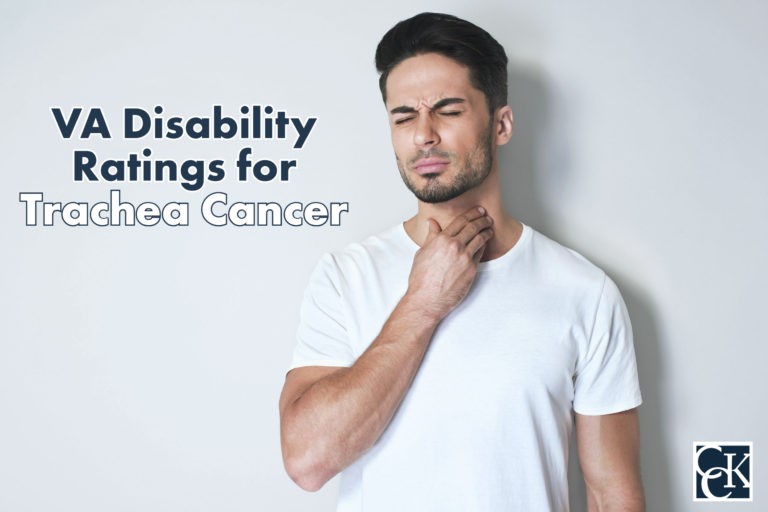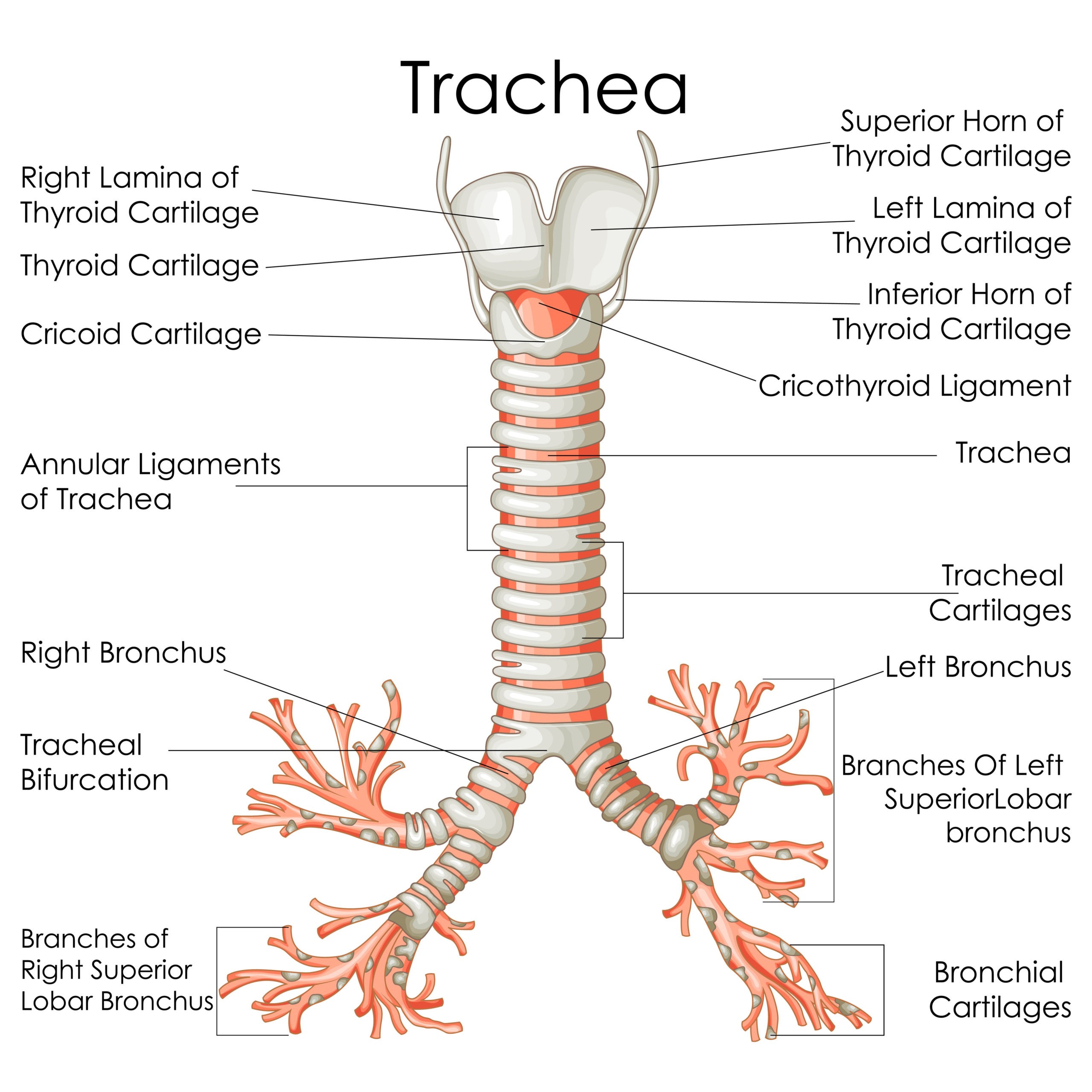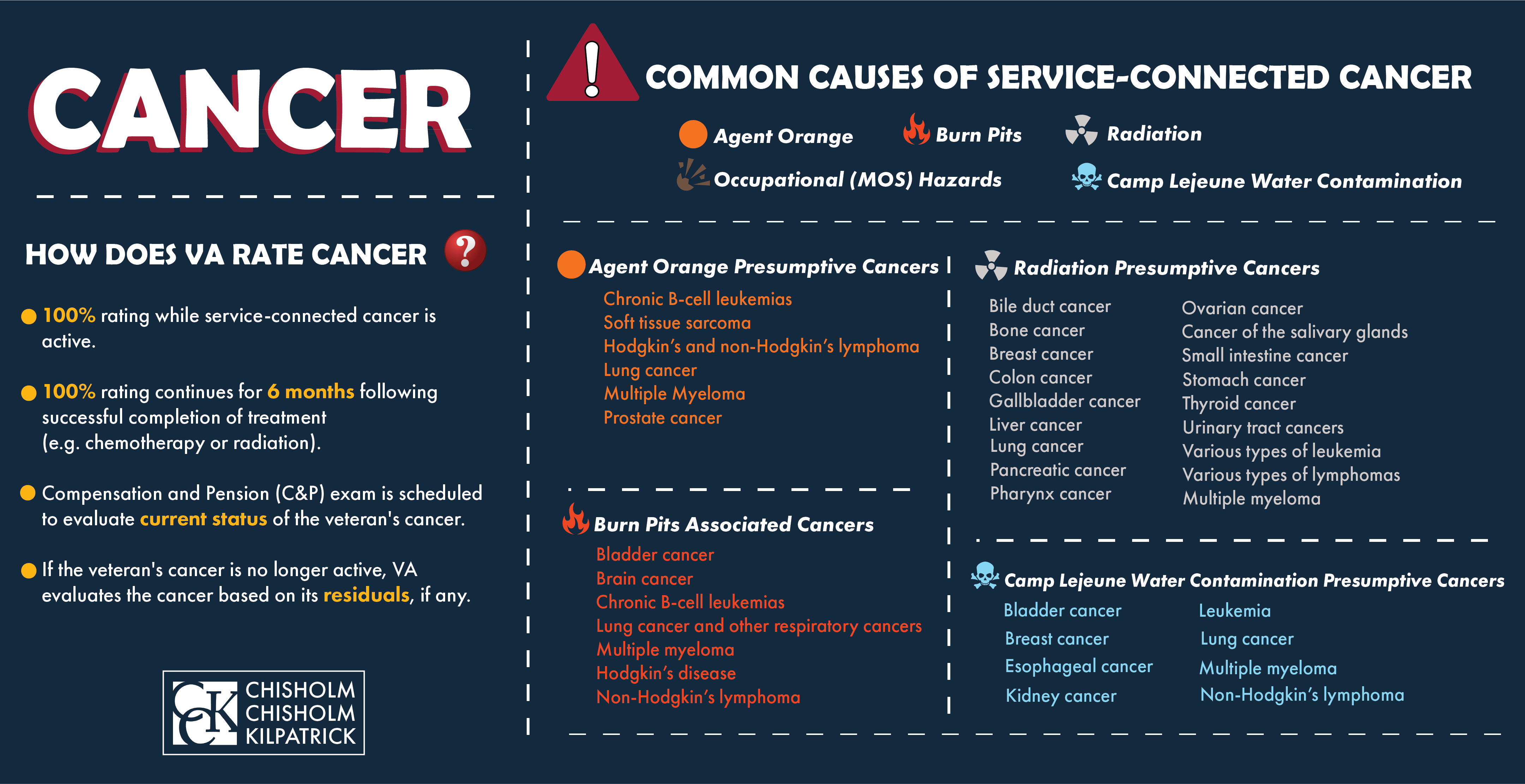VA Disability Ratings and Benefits for Trachea Cancer

What is Trachea Cancer?
Trachea cancer is a form of cancer that can develop in the windpipe, or trachea. The trachea is an airway that connects the nose and mouth to the lungs. The trachea splits into two tubes, the left, and right bronchi, which lead into the lungs. Tumors that are on the trachea can even spread to other organs, such as the esophagus or thyroid. This is called metastasizing. When tumors form on the trachea, they may cause it to narrow, limiting airflow into the lungs.
Symptoms of Tracheal Cancer
- Loss of breath
- Consistent cough
- Coughing up substances such as blood
- Wheezing
- Difficulty swallowing
- Raspy or hoarse voice
- Fever
- Chills
- Chest infection
Forms of Trachea Cancer
- Squamous Cell Carcinoma—This is the most common form of tracheal cancer. This tumor grows fast and usually forms in the lower trachea. It can sometimes “penetrate the mucosal lining of the airway as it grows” which can cause ulcers and bleeding. This form is more common in men than in women and smoking can be a major trigger.
- Adenoid Carcinoma—This kind of trachea cancer is less likely to puncture the mucosal lining than squamous cell carcinoma. Tumors in this form of cancer grow slowly and can close off the airway as they grow.
- Carcinoid tumors—Tumors in this form grow from neuroendocrine cells, which are cells that produce hormones. Though less common than the above-mentioned forms, carcinoid tumors may form in the bronchi.
- Chondromas—This form of tumor is the most common benign form, meaning that it is not cancerous. Usually, they form in the cartilage rings of the trachea and in the larynx.
- Hemangiomas—These are growths that occur in the trachea from the abnormal buildup of capillaries.
- Papillomas—These tumors are suspected to be caused by HPV, or human papillomavirus.
Diagnosing and Treating Trachea Cancer
Diagnosing trachea cancer may take the expertise of a respiratory specialist or a doctor who specifically treats the ears, nose, and throat. These specialists may take a CT scan, or computerized tomography, of the person’s trachea or surrounding area which may be affected by the tumor. Other tests could include an x-ray, MRI, ultrasound, biopsy, or lung function test.
There are generally three stages of tracheal cancer, which are used to describe how far the cancer has progressed. Early trachea cancer usually is caught when the cancer is only in the trachea. When trachea cancer is locally advanced, it has spread into other areas of the body, usually near the trachea. Metastatic, or advanced, trachea cancer has spread to other organs surrounding the trachea, like the lungs, larynx, or even bones.
Treatment for tracheal cancer may be dependent on what stage of cancer the person is experiencing. Forms of treatment for tracheal cancer may include surgery, radiotherapy, or chemotherapy. A doctor or specialist will usually determine what form of treatment is the best option for each person.
VA Service Connection for Trachea Cancer
When filing a claim for service connection for trachea cancer, the veteran will need to demonstrate a connection between their military service and their trachea cancer. The veteran will also need to submit a diagnosis of their condition. In total, the veteran will need to submit the following to VA:
- A diagnosis of trachea cancer;
- An in-service event, illness, or injury; and
- A nexus linking the veteran’s in-service occurrence with their trachea cancer
In the instance of presumptive service connection, the veteran will not necessarily need a nexus linking the veteran’s in-service occurrence to their trachea cancer.
To support the veteran’s claim for service connection, the veteran may submit lay evidence. Lay evidence, or lay statements, can be written by the veteran or anyone who knows the veteran and can speak to their condition. Importantly, lay evidence may also be submitted by fellow service members.

Compensation and Pension (C&P) Exams for Trachea Cancer
Once a claim has been filed for trachea cancer, VA may request a Compensation and Pension exam, or C&P exam. It is crucial that VA has the veteran’s up-to-date contact information so that the veteran does not miss any C&P exam requests, which usually come via phone call or letter. It is also very important to attend the exam, as failure to attend can result in a denial of the veteran’s claim.
The exam will usually be performed by a VA physician or a VA contracted physician. Before the exam, the examiner will review the veteran’s c-file, which contains any documentation that has previously been submitted to VA, as well as the veteran’s medical and service records. During the exam, the examiner may physically exam the veteran, focusing on the areas that may be affected by trachea cancer.
The veteran may also use a DBQ, or Disability Benefits Questionnaire, to bolster their claim. A Disability Benefits Questionnaire is a form created by VA that allows veterans to address important aspects of their condition, such as symptoms, severity, possible causes, and relation to other disabilities. The veteran may also have their private doctor fill out a DBQ for them. In claims for trachea cancer, a cancer specialist or an ears, nose, and throat doctor who treats the veteran may be able to provide insight into the veteran’s cancer.
VA Ratings for Trachea Cancer
If a veteran is service-connected for an active cancer, VA should automatically assign a 100 percent disability rating. This rating will continue as long as the veteran’s cancer is active. After six months following the veteran’s successful treatment program, which can include chemotherapy, radiation, or surgery, VA will schedule the veteran for a C&P exam to re-evaluate their condition. If the veteran’s cancer is in remission, then VA will evaluate the cancer based on its residuals.
Burn Pit Exposure and Trachea Cancer
Trachea cancer has been linked to veterans who were exposed to military burn pits during their service. Military burn pits are large areas of land in which the military and its contractors incinerated all waste generated by military bases.
The United States military used burn pits as part of its waste disposal protocol in places such as Iraq and Afghanistan in the post-9/11 era. The practice was effective in reducing large quantities of waste, but the pits emitted plumes of toxic smoke.
Materials such as human and medical waste, plastic, rubber, petroleum, and ammunition were disposed of in burn pits. Toxins released when these materials were burned have been linked to numerous different health conditions, including trachea cancer.
At this time, there is still much research to be done in order to better understand the long-term health impacts of burn pits. However, research has indicated that the main dioxin released by burn pits, called TCDD, was also one of the major toxins in Agent Orange.
While VA does acknowledge certain conditions as being eligible for presumptive service connection if the veteran can prove exposure to Agent Orange, VA has not established a presumption for veterans exposed to burn pits. Since there is no presumption, VA adjudicates burn pit claims on a case-by-case basis.
VA does not have a consistent approach to deciding these claims, so lay evidence from veterans is key to winning burn pits claims. Often, VA does not have a way of proving whether veterans where near burn pits, so buddy statements or statements from the veteran themselves can help prove exposure.
New Proposed Burn Pit Legislation 2021
As of 2021, there are several major bills currently pending in the Senate, and one in the House of Representatives, that deal with the toxic exposure caused by burn pits. These bills include:
- Conceding Our Veterans’ Exposure Now and Necessitating Training Act (COVENANT)
- Presumptive Benefits for War Fighters Exposed to Burn Pits and Other Toxins Act of 2021
- Veterans Burn Pit Exposure Recognition Act
- Toxic Exposure in the American Military Act (TEAM)
Any of these bills, if passed, would offer much-needed relief to veterans suffering the toxic effects of burn pit exposure. Specifically, the COVENANT Act would create a presumption of service connection for veterans who were exposed to military burn pits during their service and went on to develop specific conditions. Any type of respiratory cancer would be included as a presumptive service connection. As the trachea is part of the respiratory system, trachea cancer would become a presumptive condition if this bill were to pass.
Was Your VA Disability Claim Denied?
The VA-accredited, experienced attorneys and advocates at Chisholm Chisholm & Kilpatrick LTD have decades of experience successfully representing veterans who have been wrongly denied VA disability benefits. For a free, confidential consultation, contact us today at 800-544-9144.
About the Author
Share this Post



